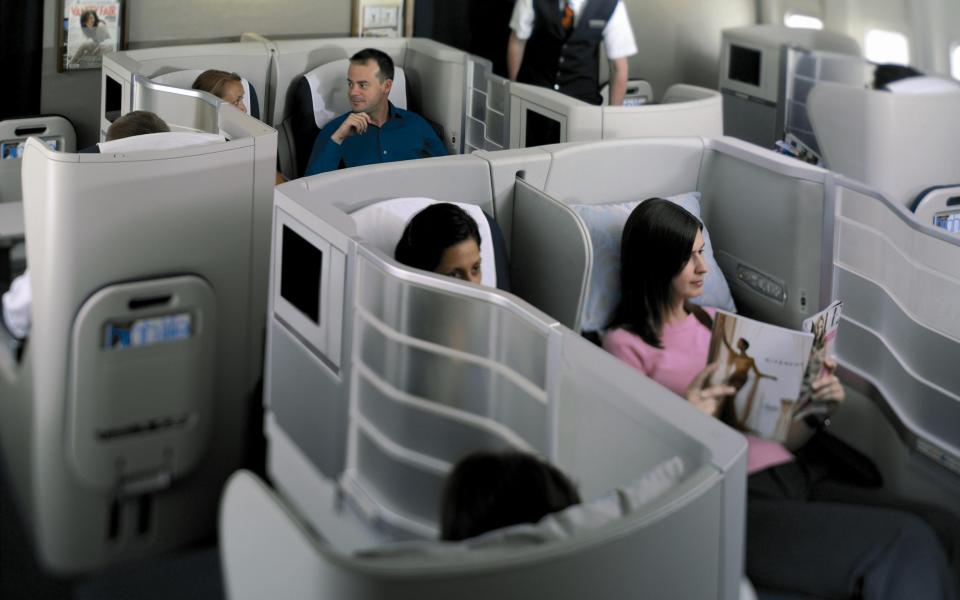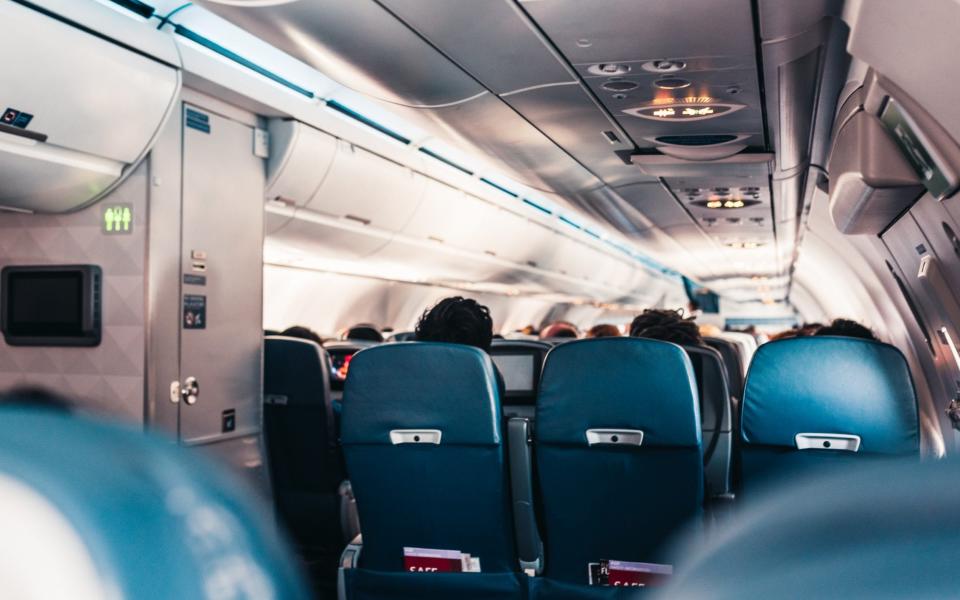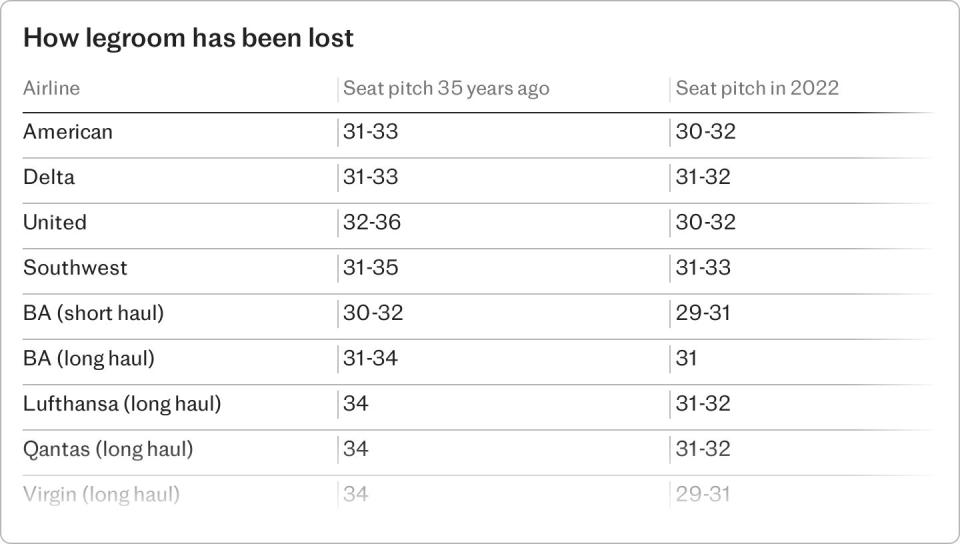The weirdest and worst seats on passenger planes

There’s been a flurry of recent newspaper articles about what might be the two most awkward seats on any aircraft: the rear-facing specimens in row one on certain planes. Nab one of these seats and, as a few viral videos on social media illustrate, you’ll need to pack your best manners because they look out onto every other seat in the cabin.
“There are a number of ATR turboprops with rear-facing seats on the starboard side,” says Gregor Milne of aircraft seating plan website Aerolopa. Watch out for them on the ATR 42-500, used on some flights with Scotland’s Loganair, among others.
In the case of a couple of higher-profile row-one rear-facers (reality TV star Caroline Stanbury and her boyfriend), an assistant purportedly booked seats 1A and 1B on a flight with Tanzania’s Precision Air assuming they were the best on the plane. It’s proof that it always pays to look at aircraft seating plans in advance.
Don’t use the prices on the airline’s seat-booking diagram to guide you. “While the specific fees may vary, they do not always equate to better seats,” says Milne. “Airlines employ complex algorithms when setting fees to specific seats and tend to assign higher fees to the most popular ones, such as those at the front of the cabin and over wing exits, rather than those, for example, that are located farther back and may offer more legroom.”
And bear in mind that not all aircraft with the same carrier are equal. Gilbert Ott of travel blog God Save The Points explains: “Fly one, have an antiquated experience from the Nineties; fly another on the same airline, you’ll be living it up with streaming Wi-Fi. Same goes for seating layouts: one plane might offer 3-3-3 [three seats, then aisle, then three seats then aisle etc] or 3-4-3, where many more people are getting middle-seated.”
Keen to avoid the weirdest and worst seats onboard? Below, we highlight the ones not to book. For tips on the best seats to choose, see our guide.
The worst seat… for views
You’ve secured a window seat, now you can admire those hazy views of clouds drifting below. Right? “For those who actively seek window seats, it pays to check first that the seat isn’t one of those that doesn’t actually have a window. Yes, these do exist,” says Ott.
Windowless window seats include the now notorious 11A, 11F and 12F on Ryanair, but plenty of other carriers have them too. In fact, the placement of air conditioning ducts on 737s means that many airlines share the problem.
Meanwhile, “BA’s Airbus A320s and A321 have pretty wretched seats in the last row, where there are no windows and the conditions are noticeably more cramped. These are definitely ones to avoid,” says Milne.
so i paid extra for a window seat….with no window pic.twitter.com/wFxR1leeCJ
— ᰔ (@si4rra) July 25, 2024
Those travelling in premium economy are not entirely safe from the phenomenon either. Opt for row 15 on some of Air France’s 777s, for example, and you could find yourself staring at a blank wall. To ensure a view, carefully examine the seat map and note any missing or misaligned windows.
The worst seat… for travel sickness
Those rear-facing seats in row one are awful for the introverted, but they also pose another problem. As one comment on Reddit noted: “The entire plane would have to watch me throw up from travelling backwards.”
Even in business class, you could find yourself dealing with nausea. Some 777s have rear-facing seats in this class, and previous passengers state that take-off and landing can be difficult. Watch out for backward-facing seats in row 10 on some of BA’s 777s, which have the added bonus of being by the lavatories. There are rear-facing seats on some 787 Dreamliners too.

Aside from these, it’s worse at the back of the plane if you’re prone to motion sickness and less bumpy over the wings or nearer the front.
The worst seat… for odours
Stale urine and plane food: not a scent that’s likely to be sold in duty free any time soon. Seats at the back are particularly prone to this unsettling aroma, but also watch out for those extra-legroom exit-row seats on long-haul flights: some face a middle bank of loos (if you’re destined for the dreaded by-the-toilet seats, nurses on social media suggest Vicks VapoRub to mask the smell).
Even armed with protective menthol or a particularly stuffy nose, these seats have their downsides. “The queues that form and congregate in the adjacent bulkhead spaces can be a nuisance if you are seated there,” says Milne.
And those middle-of-the-plane seats have another disadvantage if you get particularly peckish. They’re often the last to get meal service, and can be the last to disembark, too.

The worst seat… for sleep
It’s hard enough to nod off in the air without any extra issues preventing shut-eye. It goes without saying that you will have less sleep if you opt for back-row seats that don’t recline, while window seats are best if you don’t want to be disturbed by other passengers.
There are other seats to be aware of, too. On some Japan Airlines 777s, for example, watch out for the second row from the back: because the plane goes from a 2-4-2 configuration to a 3-4-3 one at that point, the seats get bumped by passengers returning from the loo, according to SeatGuru.
If you’re hoping for a mid-haul snooze, you might encounter problems. “Longer flights in Europe continue to be a real challenge because few airlines operate them like a long-haul flight,” he adds. “They use short-haul aircraft and these smaller aircraft with smaller seats get really uncomfortable. If you ever see a ‘widebody’ Boeing 767, 787, 777 or Airbus A330, A340 or A350 on a route that mostly has short-haul planes, like an Airbus A320 or Boeing 737, definitely take the widebody.”
If you’re lumped with the latter, avoid the back of the plane. “On narrow-body aircraft such as the Airbus A320 and Boeing 737, seats at the rear of aircraft tend to be slightly narrower than standard ones, taking into account the narrower fuselage at the rear of the aircraft. This usually affects only the seats in the last two rows of the cabin,” says Milne.
Lastly, if it won’t do to dribble on a flight attendant as you drift off, avoid row 10 of American Airlines’ A321. It has two seats and then a jump seat for cabin crew where the third passenger should be, according to TikToker @jetset.genius (who is actually a fan of this seat due to its extra space).
The worst seat… for space
Generally, 2023 research by Which? found that Virgin Atlantic’s seats and pitches were among the least generous for long-haul flights, with Tui scoring badly for short hops. But most airlines are fairly similar, offering around 31-32 inches of legroom – or seat “pitch” – on long-haul services, and 29-30 inches for short-haul.

Even roomy bulkhead seats can have inconveniences such as a lack of underseat storage space, as well as in-armrest entertainment and tray tables which mean narrower seats. “The other issue is that the screen (when deployed) is positioned much lower than on other seats, and is often slightly smaller. Due to their low and upward tilted position, they are affected by glare much more than others,” says Milne.
It’s not the only in-flight entertainment system issue to be aware of onboard. Watch out for housing boxes hanging down under the seats. “They can intrude into the footwell. On some long-haul aircraft six out of 10 economy class seats are affected,” says Milne. “Fortunately, thanks to technological advances, these boxes are being replaced by smaller units that sit inside the seat pan and don’t get in the way of your feet. Examples of the former can be found on BA’s Boeing 787s and Airbus A380s. The newer units are fitted to BA’s Boeing 777s and Airbus A350 as well as recently refurbished 787-8s.”


